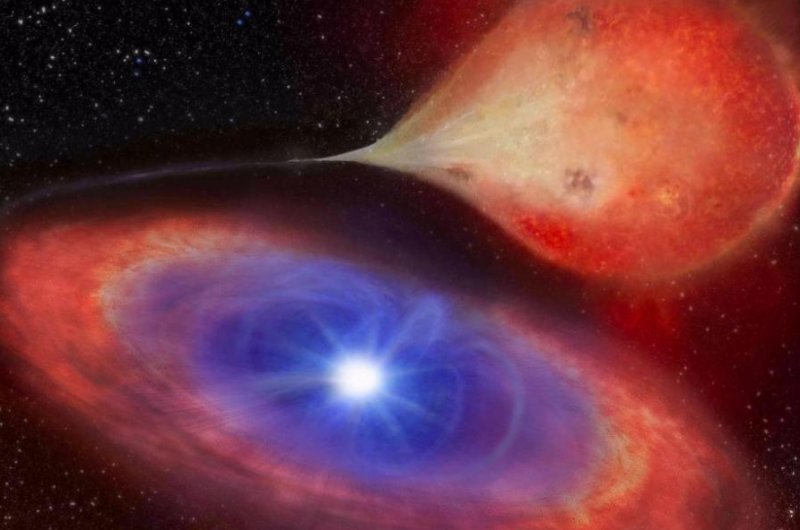An artistic rendering shows a white dwarf accreting material from its stellar companion. Photo by Helena Uthas
Dec. 14 (UPI) -- It turns out white dwarfs, long classified as "non-magnetic," have magnetic fields.
In studying the consumption patterns of white dwarfs, astrophysicist Simone Scaringi discovered magnetic gates explain the starve-binge growth patterns of white dwarfs.
"We have seen episodes of strong flares of accretion interrupted by periods with no evidence of accretion," Scaringi, a researcher at the University of Canterbury in New Zealand, said in a news release. "This sporadic activity is best explained by the presence of a strong magnetic field comparable to that of 1,000 fridge magnets."
White dwarfs are what sun-like stars become after they've used up all their nuclear fuel. No longer able to generate fusion, the dead stars shrink to roughly the size of Earth -- but still with the mass of the sun.
White dwarfs grow by robbing material from other bodies. Usually, they accrete material from a companion star. Years of studying white dwarf growth patterns showed the orbs grow very slowly.
Most of the time they're starved for material. When they do accrete material, it happens all at once, in sudden bursts.
In studying patterns among white dwarf data collected by NASA's Keppler observatory, Scaringi found a white dwarf behaving as if it boasted a strong magnetic field.
In his latest paper, published this week in the journal Nature, Scaringi argues that magnetic fields best explain why white dwarfs accrete material all at once.
"This magnetic field 'gates' the accretion, causing the matter to pile up until it has a gravitational attraction stronger than the magnetic forces holding it back, indicating for the first time that even 'non-magnetic, white dwarfs can have very strong magnetic fields," Scaringi said.
The new findings don't distinguish white dwarfs from other stellar objects as much as showcase the universal patterns of "magnetospheric accretion."
Similar patterns of binge-eating are exhibited by black holes, neutron stars and young proto-stars.
"Now we have further evidence that magnetic accretors like the one in our paper also behave in the same way, irrespective of their origin," Scaringi said. "Similar bursts have been observed in accreting neutron stars -- which are much smaller and have magnetic fields much higher than our white dwarf -- and in young stellar objects, which are on the other end, being much larger and owning much weaker magnetic fields."















